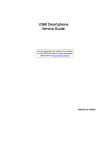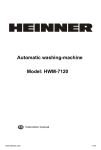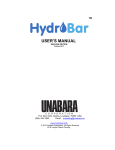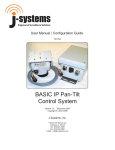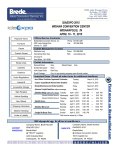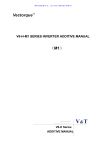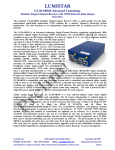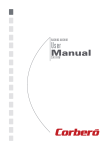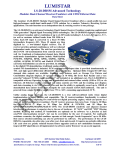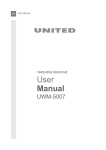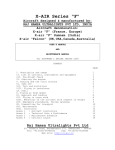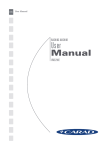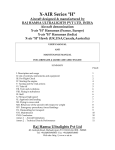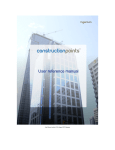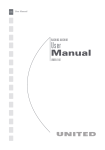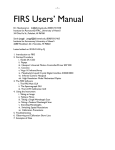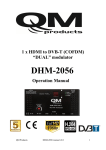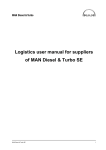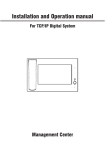Download Product Life Management & Design Issues Team 13 Tuneable Light
Transcript
Product Life Management & Design Issues Team 13 Tuneable Light Source John Foxworth Cynthia Patrick Ruben Valencia Haosheng Liu Isaac Davila Product Life Management: When developing a product it is important to consider the products lifecycle in order to decide if the product is even worth developing in the first place. There are five stages to a product: 1) Design 2) Production 3) Distribution 4) Consumption/Maintenance 5) Retirement: reusable, recyclable, disposable In the design stage you must consider standards, delivery time, the needs of the customer, potential for upgrade, testability, and efficiency. Standards are required elements that can be mandated by the consumer or by federal law. For our tunable light source we were required to 2 use LEDs that could illuminate an area of .1 mm with a power output of .1 W. The delivery time for a product is the time period you have to produce a minimum number of complete units for the market; since our product was for a student fair the delivery time was easy to meet since we only needed to produce one unit. The needs of the customer is simple as it sounds; what the customer requires out of the product once they purchase it. When designing our tunable light source we considered that the customer needed the device to be small enough to be portable, cover a range of wavelengths between 400 nm 1100 nm at twentyfive peak points, and be usable via a USB cable and laptop interface. We developed our design in such a way that it can easily be upgraded to include more peak wavelength points and provide more power with some simple tweaks to the hardware and software. The testability of a product means that it can easily undergo a test to verify it is working properly; this is especially important for us since out tunable light source is a component for a testing apparatus itself. We plan to establish a calibration method using a photodetector that verifies the power output at specific wavelengths. Energy efficiency for a product means that it operates with very little power loss; essentially all the power put in is used for a required task. For our tunable light source we used LEDs which are extremely energy efficient and a simple microcontroller so our design will need a simple 5 V battery and use most all the power. The production stage of a product involves manufacturing cost and safety, energy consumption, materials logistics, production time, quality control, and environmental considerations. In order to maximize profit manufacturing you need to use low cost materials and methods for prodcuction; for our project we choose low cost materials that worked efficently and built it ourselves with just our hands so no budget needed for machine work. In the manufacturing enviroment it is essential to consider safety; you want a safe enviroment for any employees buliding a product as well as wanting the product itself to be safe. Energy consumption is what it takes to produce the product; for us the energy consumption is very low since for assembly we only need power to sauter connections and power testing equipment. You must also consider how much energy the product will consume durnign use; our design requires a simple 5 V battery. Materials logisitics are how readily available materials are and if you have enough of them to correctly assmeble the product. So far the only major issue for the tunable light source’s materials logistics is the availibility of proper lenses in the United States; our top choices for lenses required shipping from china which we did not have time for. Production time is important because it is what determines if a product can meet a delivery date for the market; we believe without using any machines we can build a full function astecially appealing tunable light source in less than twentyfour hours. Quality control in a products lifecylce means that when selling multiple units of the same products all units are of the same quality and work optimaly. For our light source the only quality control issue we had to deal was ensuring we assembled the product using quality parts, for example LEDs that function idealy. Environmental considerations are exactly as they sound, you have to consider how your product will affect the environment around it. For example you do not want a consumer product to have toxic materials in it that they can easily be exposed to. In manufacturing there are many environmental and energy considerations to account for like trying to minimize toxic chemicals used to manufacture, minimizing use of heavy metals, and minimize power consumption. Most importantly there are legal mandates on the manufacturing process. These mandates cover issues like how many chemicals can be emitted into the atmosphere during the production process, how many toxic chemicals can go into a product, how to dispose of toxic materials, how to dispose of used solvents or acids, and the electromagnetic compatibility of the product. Another legal mandate to consider is Extended Producer Responsibility (EPR) which states that the producer bears responsibility for the life cycle, environmental, and health impacts of their products. This means that if a product has any negative impacts, even if they are caused by product misuse, the producer can be held responsible hence you want to design and produce the best and safest product possible. We do not have to worry about most of the legal mandates since the companies that produced the components of our light source already compensated for them; we merely have to ensure we use an appropriate material for the housing. The distribution stage of a product involves the transportation time and cost, the available inventory, and a sales network;this stage is all about getting the product to the consumer. The time and cost of transportation involves choosing a mode of delivery to the consumer and how much will it cost you. If selling directly to consumer you would probably charge them shipping and use a service like UPS the can expedite shipping all the way to as short as overnight. If selling to a 3rd party that will sell to the consumer you will have to find a cheap efficient way to ship multiple units; if the product is mostly sold to a 3rd party it would be best to establish an independent shipping method, usually semitrucks, planes, or combination of both. Available inventory is all about ensuring that you have as many units of a product that you promised to sell. A sales network is the method of how the consumer buys the product; as mentioned above the product can be sold directly or through a third party retailer. At this time we do not have to consider distribution issues since we are only making one unit; but if the time comes we believe our biggest issue would be establishing a consistent sales network. The consumption stage is composed of customer training, maintenance, spare parts, upgrades, and again energy use. Customer training for a product is usually a user manual but for more complex products some companies choose to produce training videos or hold training classes. Maintenance and spare parts go together, they are concerned with the ability to keep the product working correctly. For our tunable light source we designed the housing to be easy access so it can be opened to easily repair or replace any part that may malfunction; is we mass produced the tunable light source we would want to provide consumers with the ability to order spare parts directly from us. Consumers want to be able to upgrade their product since there is always the desire to have the newest and the best. Upgrades can range from newer better hardware that gets replaced to just a simple upgrade to the programming that would just need to be downloaded. The accessible housing makes any upgrades easy and also allows the consumer to upgrade the basic design to suit their specific need for it. Energy use in the consumption stage is all about the energy required to use the product; as mentioned for us the energy use is low requiring only 5 V to operate. The final stage of retirement is about the lifetime of the product, tradein possibility, end of customer support, reuse, and disposal/recycling of materials. The lifetime is how long the product operates before it starts to become a drain, most products only last a few years as they are before needing any replacement parts, longer if properly maintained. The possibility of tradein is if the company that produces that product allows you to trade it in or upgrade it to the newest model, usually if you do this as a consumer you get a discount on the new product if you turn in your old one since the seller can reuse some of the old products components. End of customer support is how long the selling company of the product provides support for any issues that come up when the consumer is using the product, this is where warranties and such would come up. Many companies have a support line that never ends to deal with small issues like how to operate, however sometimes this support has a cost to the consumer usually after having the product for a certain amount of time or requiring extra assistance. Reuse is if the product can still be used once the customer is done with it, this usually applies if the product has a long lifetime or can easily be converted to a different use. For our tunable light source it can easily be reused since with a few simple adjustments it can be applied for multiple uses beyond testing solar cells. Disposal is how your get rid of the product once the consumer is done using it. A simple product like a carton of milk could just be thrown away but more complex products, like electronics, require specific disposal methods. Electronic equipment is assembled with over one thousand different types of materials many of which are toxic like mercury, lead oxide, acids, plastic additives, certain gasses and many more. Due to this there are legal mandates on how these electronic products need to be disposed of or recycled for reuse which resulted in the EPA’s Energy Star Program and other such programs where product produces take back the product and dispose of it free of charge once the consumer is done with it. Many companies can acually save money by doing this since there may be some salvagable parts of a product that can be recycled for continued use. If we were to mass produce the tunable LED light source we would need to link with such a program since it will be composed of many electronic elements that need proper disposal/recycling. Design Issues: Design for Accessibility: In the United States, there has been a long history of movements to improve the civil rights of its people. Each movement addressed a different issue that meant to ensure specific rights before the law. One example was the disability rights movement which brought the needs, concerns and rights of people with disabilities to national attention.Out of this movement came two significant laws which address those issues. These laws were the Americans with Disabilities Act of 1990 and the Rehabilitation Act of 1973. The goal of these laws was to ensure an equal opportunity for people with disabilities. This is where the concept of “Design for Accessibility” comes into play. This concept is about designing products so that they can be used by anyone, including those with disabilities. Since Michigan State University is a federally funded organization so it is obligated to comply with these laws. Ultimately our design will be used in a laboratory for one of the electrical engineering courses. So our design must therefore complies with these regulations. Initially our project was not designed with accessibility in mind. We made the assumption that it would be used in a research lab. We figured that its end user would be researchers not need special accommodations. For this reason our original design was not made to aid someone with special needs, disabilities or impairments. At the end of the day if we want our design to be marketable we must redesign so anyone can use it. There are several components of our design we must redesign in order for anyone to use it. These three components are the physical user interface, the graphical user interface or GUI and the display on the device. Theres are many kinds of impairments. For our design we will be focusing on aiding with visual, hearing, mobility impairments. The physical user interface only has a knob to control intensity and another knob to control wavelength. This design makes it very hard for someone with a mobility impairment to use. For that reason larger knobs and buttons will be used to allow such users to accurately adjust each parameter with minimal effort. The knobs can also have a slight resistance to turning, making accidental overshooting less likely. Additionally, braille labels can be placed under each physical user interface input, and each knob/button to be clearly identifiable by touch (ie. raised buttons and knobs with tactile regions to indicate its position). The display is also designed for someone without disabilities. To better serve the visually impaired, an auditory feedback loop would be implemented. Rather than a visual display to relay information on the color, wavelength, and power, a speaker will inform the user of all three parameters any time they are changed. In order to recreate a custom intensity versus wavelength graph, the microcontroller requires an input of 25 data points. Each of these data points represents the relative intensity of each LED. The program that acquires the data points and writes them to each LED can be easily modified to accept values from multiple sources. For our design, we will implement two separate input methods to the GUI. The first and primary method would be to adjust a series of sliders, much like an equalizer for an audio application. Each slider will adjust the intensity of an individual wavelength. Below each slider, a text box will display the value (as a percentage) of the intensity. This text box will also be editable, meaning if the user would rather type values instead of adjusting sliders, they can do so. Many products exist to help handicapped individuals use computers. for example, a person with impaired motor skills will likely have a trackball mouse, which allows more precise and accurate movements. By allowing multiple input methods, our design not only gives the user more options to choose from, but also allows anyone who can operate a computer to use our product. Standards : The Food and Agriculture Organization (FAO) of the United States implements and promotes statistical standards, guidelines and tools. The standards of the products need to provide the optimum degree of achievement in order to provide the customer with a useful tool. ISO/IEC Guide 2:1996, definition 3.2 defines a standard as: 'A document established by consensus and approved by a recognized body that provides for common and repeated use, rules, guidelines or characteristics for activities or their results, aimed at the achievement of the optimum degree of order in a given context'. The standard for the portable light source is to provide spectrum range of 400 nm to 1100 nm with 25 different testing points that have enough optical output power to test solar panels. However, the product is intended to be used for a university laboratory experimentation purposes. This product will need to output accurate spectrums and power in order for the user to make an efficient use of the device. The portable light source contains an LED array to represent a spectrum range from 400 nm to 1100 nm with 25 different test points. The issue that was encountered with the LEDs is that they are directional and can be difficult to focus the array to a common point by using simple lenses. Particularly, since each LED will propagate light from a different direction. In order to properly focus the light to common point, the lenses will need to be significantly small so that they can be applied to every individual LED. Not only are the lenses costly, but also finding these particular lenses can be difficult. Applying lenses to each individual LED will sacrifice the size of the portable design. This will make the device more rigid and less attractive for the tester. It was noted that applying a fiber optic cable to every individual LED will provide a better focusing for every wavelength. However, applying this method will not only increase the cost and the rigidness of the device, but also sacrificing the power output of the LEDs. As shown in Figure 1, it can be noted that an LED array has more light distribution than the one from a beam and therefore, creating a significant power loss. In addition, there would need to be 25 different outputs and making the option of a single fiber optic cable for testing solar panels futile. Figure 1. LED vs Beam Wavelength through an optical wire. After use of lenses to focus and redirect the light an area of 1mm2 must be illuminated directly. Since we do not want to move the entire device to test the power output we believe that fiber optic cables are the best choice to propagate the light that is outputted from the device. However ideal fiber optic cables are very expensive; due to our limited budget we may choose less expensive fiber optic cables. The less expensive fiber optic cables will likely have more power losses than more expensive cables;which can affect our ability to meet the power requirement of 0.1 W needed to accurately test a solar cell (the purpose of this light source). The accuracy of the tunable light source is extremely important, little error may cause a wrong experiment result. At the first time, the team apply 25 fiber optic cables to each LED. The advantage of this idea is that it can make sure all the light come into the cables and no power loss before spread into the cables, the disadvantage is that it cost too much. To make sure the cost not beyond the budget, the team use two lens to focus and redirect the 25 LEDs’ light first, then direct them into a few cables. In this way the project only need a few cables, but it will have some power loss before go through the lens, because the light going out of the LED is in different directions, we cannot make all the light from the LED go through the lens. Resources: http://www.fao.org/statistics/standards/en/ for FOA











